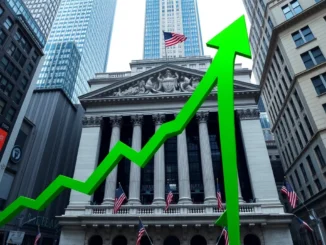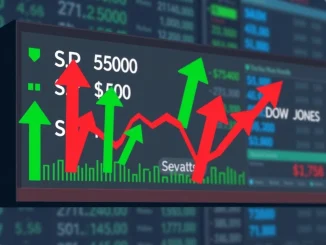
Even for those deeply focused on the world of Bitcoin and other cryptocurrencies, keeping an eye on traditional markets like the U.S. stock market is crucial. Why? Because often, shifts on Wall Street can send ripples across the entire investment landscape, influencing investor sentiment and capital flows. Today, the news from the traditional side wasn’t bright: the major U.S. stock market decline saw key indices close significantly lower.
Understanding the Latest Market Downturn
The end of the trading day brought disappointing numbers for investors tracking the performance of leading U.S. companies. This latest market downturn reflects a cautious, perhaps even fearful, sentiment prevailing among traders. Here’s a quick look at the closing figures:
| Index | Closing Change |
|---|---|
| S&P 500 | -0.84% |
| Nasdaq Composite | -0.91% |
| Dow Jones Industrial Average | -0.7% |
These percentages, while not catastrophic in isolation, represent a broad-based pullback across different sectors of the economy. The S&P 500, tracking 500 of the largest U.S. companies, and the Dow Jones Industrial Average, representing 30 significant stocks, both felt the pressure, alongside the tech-heavy Nasdaq.
Why Did the Nasdaq Close Lower?
The technology sector, heavily represented in the Nasdaq close, often acts as a bellwether for growth stocks and overall market risk appetite. A notable drop here, at -0.91%, suggests particular weakness in this area. Several factors could contribute to this:
- Inflation Concerns: Persistent worries about rising prices can erode the future earnings potential of growth companies, making their current valuations look less attractive.
- Interest Rate Expectations: Higher interest rates increase borrowing costs for companies and make safer investments like bonds more appealing compared to riskier tech stocks.
- Economic Outlook: Uncertainty about the strength of the economic recovery or fears of a potential slowdown can lead investors to sell off assets perceived as more sensitive to economic cycles.
While the exact catalysts for today’s specific moves are subject to analysis, these broader macroeconomic themes often play a significant role in shaping the narrative around indices like the Nasdaq.
What Does the S&P 500 Today Tell Us?
The performance of the S&P 500 today is a strong indicator of the overall health and sentiment across a wide range of industries. Its decline of 0.84% signals that the selling pressure wasn’t confined to just one sector but was more widespread. This suggests that factors affecting the broader economy or general investor confidence were likely at play.
When the S&P 500 moves lower, it often reflects concerns about corporate earnings, consumer spending, or geopolitical events that could impact a diverse group of companies. For crypto investors, this widespread traditional market weakness can sometimes correlate with similar cautious behavior in digital asset markets, although the relationship is complex and not always one-to-one.
Analyzing the Dow Jones Loss
The Dow Jones loss of 0.7% rounds out the picture of a challenging day for traditional equities. As an index representing established, large-cap companies, the Dow’s movement can sometimes reflect sentiment around traditional industrial and financial sectors. A decline here, alongside the S&P 500 and Nasdaq, paints a consistent picture of risk-off sentiment.
The synchronized movement across all three major indices is noteworthy. It suggests that investors were reacting to overarching market forces rather than sector-specific news. This kind of broad-based selling can sometimes precede periods of increased volatility.
Implications for Investors (Including Crypto Enthusiasts)
So, what does a day like this mean, especially if your portfolio includes cryptocurrencies?
- Correlation vs. Decoupling: Historically, crypto markets have shown some correlation with tech stocks (like the Nasdaq). A downturn in stocks can sometimes lead to a similar dip in crypto as investors reduce overall risk exposure. However, many in the crypto space hope for or predict a ‘decoupling’ where digital assets move independently. Days like these test that theory.
- Sentiment Shift: Broad market fear can spill over. If traditional investors are pulling back, it can influence the mood in riskier asset classes like crypto.
- Opportunity or Warning? For some, a dip in traditional markets might be a warning sign of broader economic weakness. For others, it could represent capital potentially flowing *out* of traditional assets and *into* alternatives like crypto, or simply present buying opportunities in both markets if they believe the dip is temporary.
It’s a reminder that the global financial system is interconnected, and understanding movements in one major area can provide valuable context for others.
What to Watch Next
Investors will be closely monitoring several factors in the coming days:
- Further economic data releases (inflation reports, jobs numbers, GDP figures).
- Statements from central bank officials regarding monetary policy.
- Corporate earnings reports to gauge the health of individual companies.
- Geopolitical developments that could impact market stability.
These elements will help determine if today’s stock market decline was an isolated event or the start of a more sustained trend.
Conclusion: Navigating Market Volatility
Today’s lower close for the S&P 500, Nasdaq, and Dow Jones serves as a reminder that market volatility is a constant. While the crypto market has its own unique drivers, paying attention to significant moves in traditional finance provides crucial context. Whether this market downturn is a temporary blip or a sign of deeper shifts remains to be seen, but staying informed across all relevant asset classes is key to navigating these uncertain times.



